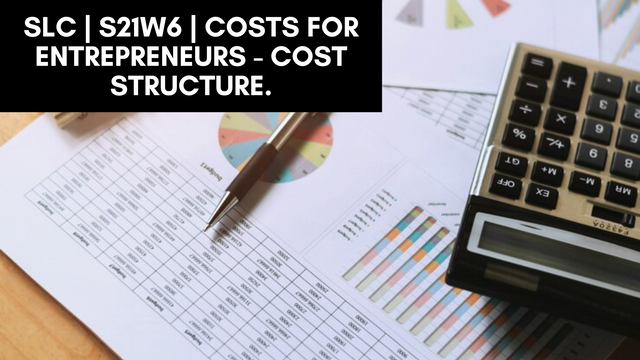SLC | S21W6 | Costs for entrepreneurs - Cost structure.
 |
|---|
What is a cost structure, and what is its importance for entrepreneurship?
A cost structure refers to the best way the expenses incurred by a business are being operated and delivered. What this means is that it is the framework of expenses a business incurs to operate and deliver quality products to the general public. Cost structure helps to outline the proportion and types of variables and fixed costs that must be managed by a business.
| Components |
|---|
As we have introduced earlier a cost structure is made up of three key components which are;
Fixed Costs: This means all extent is constant irrespective of the output such as administrative salaries, insurance, and leases. All these are components of fixed cost since they remain constant regardless of output.
Variable Costs: This means the cost of expenses that fluctuate with sales volume or production such as commissions, manufacturing costs, and shipping costs.
Semi Variable Costs: This means costs that include both variable and fixed cost components such as utility bills that have a base charge plus fees usage.
| Importance of cost structure for entrepreneurs |
|---|
 |
|---|
For entrepreneurs cost structure is very important in the following ways;
Pricing Strategy: It helps entrepreneurs to set prices that are competitive in the market but yet profitable. What this means is that cost structure aids in setting prices.
Understanding Profitability: It helps entrepreneurs to be able to identify all costs in production to determine how much revenue is needed to cover expenses so profit can be achieved.
Break-even Analysis: It is important for calculating the break-even point, where total revenue is equal to total costs which an entrepreneur can ascertain easily.
Strategic Planning: It helps entrepreneurs to plan for growth, forecast budgets, and adapt to market changes at any time.
Business Validation: It helps entrepreneurs validate whether their business model is financially okay or not.
Cost Management: It helps entrepreneurs identify opportunities and reduce unnecessary spending that can lead to the collapse of a business.
Provide examples of businesses that use the cost structure methods explained; explain your answers.
Talking about cost structure methods it simply refers to how businesses allocate costs on their operations such as production which here, I have provided examples of businesses.
| Cost Structure | Examples | Explainations |
|---|---|---|
| Cost-Driven Structure | Spirit Airline, and Ryanair Airline. | Based on the explanation, the companies focus on minimizing costs through operational efficiency, which is mostly at the expense of premium service which they achieve by; offering optional Add-on- for extra charges, using a single airplane type to simplify maintenance, and so on. |
| Value-Drive Structure: | Rolex and Louis Vuitton | Based on the explanation, the companies focus on providing premium products which are mostly at a higher price point. These companies prioritize; brand reputation, high-end customer experiences, craftsmanship and superior quality which customers are very much willing to pay for more brands. |
| Fixed Cost-Heavy Structure: | Disney+ and Netflix | Based on the explanation, the companies invest more in fixed costs such as licensing agreements and content creation. Irrespective of the number of subscribers, the cost of producing a series remains constant. |
| Variable Cost Heavy Structure | Lyft and Uber. | Based on the explanation, the companies have significant variable costs that are tied to drivers' earnings, maintenance, and fuel. In this costs fluctuate directly with the number of rides completed. |
| Mixed Cost Structure | McDonald's Restaurants | Based on the explanation, both fixed costs and variable costs are incurred. The mix ensures stability through scaling variable costs based on customer traffic. |
What are the elements of a cost structure? Provide examples,
 |
|---|
When talking about the elements of a cost structure we are simply referring to the proportions and types of cost a business incurs to produce goods or render services. For pricing, profitability, and understanding the overall financial planning of a business it is important to have a deep understanding of the element of a cost structure which here I have shown you with an example.
Fixed Costs: As we keep saying these are costs that remain unchanged (constant) regardless of volume of production. For examples: Depreciation of machinery, Insurance premiums, Employees' salaries, and Rent of factory space or office space.
Variable Costs: As we have said before now, these are costs that directly fluctuate with the level of sales or production. For example; raw materials, direct labor costs for hourly workers, utility costs associated with production, and costs of packaging.
Semi-variable Costs: This means costs that have both the components of variable and fixed. For example; utility bills with usage-based pricing and base charge and sales commission.
Direct Costs: When we talk about direct cost we simply mean the costs that we can trace directly to the production of goods or the services we render. For example; wages of assembly line workers, ingredients in food production, and components in electronics manufacturing.
Indirect Costs: These are a type of costs that aid production but cannot be directly traced to a specific product. For example; office supplies, facility maintenance, and administrative salaries.
Operating Costs: These are costs that are related to the day-to-day operations of a business. For example; logistics & transportation, marketing & advertising expenses.
Prepare the cost structure of a business dedicated to making cakes. It has a production of 5 cakes per day and expects to obtain a total profit margin of 25%.
Based on the given questions above our cost structure of a business dedicated to making cakes will be prepared as shared below.
Variable Costs Per Cake
| Ingredients | $10 |
|---|---|
| Packaging | $2 |
| Utilities | $1 |
| Labor direct | $5 |
| Total | $18 |
Fixed Costs (Monthly)
Based on the question it is assumed that 25 production days per month 5 cakes/day.
| Rent/lease | $500 |
|---|---|
| Utilities | $100 |
| Depreciation/Maintenance of Equipment | $50 |
| Marketing and Branding | $150 |
| Administrative Expenses | $50 |
| Total | $850 |
Production Volume
| Daily Production | 5 cakes |
|---|---|
| Monthly production | 5 cakes/day × 25 = 125 cakes |
Pricing Strategy
For us to achieve a 25% profit margin, the selling price will have to cover both the desired profit and the costs.
- Total Monthly Costs:
| Variable costs | $18/cake × 125 cakes = $2,250 |
|---|---|
| Fixed costs | $850 |
| Total | $3,100 |
- Revenue Target
| Total costs | $3,100 |
|---|---|
| Profit | 25% of Revenue |
| Revenue | Total costs ÷ (1 - Profit Margin) |
| Revenue | $3,100 ÷ 0.75 = $4,133 |
- Price per cakes
This equal to Revenue ÷ Monthly production = $4,133 ÷ 125 = $33
The selling price per came = $33
Profit Calculation Monthly
| Revenue | $4,133 |
|---|---|
| Total Costs | $3,100 |
| Profit | $4,133 - $3,100 = $1,033 |
I am inviting; @dove11, @simonmwigwe, and @ruthjoe
I will join you later, thanks!
I will expecting to read yours
Congratulations, your post has been upvoted by @scilwa, which is a curating account for @R2cornell's Discord Community. We can also be found on our hive community & peakd as well as on my Discord Server
Felicitaciones, su publication ha sido votado por @scilwa. También puedo ser encontrado en nuestra comunidad de colmena y Peakd así como en mi servidor de discordia
You actually did a very detail job here. It was self explanatory for me I must truly confess
Your method of analysis is commendable. In particular, the way in which the cost structure of a bakery business is proposed is instructive. Looking forward to more of your posts. Good luck for this contest.
I appreciate your support. Thanks
Greetings @ josepha
1.- You have shared the concept and importance of the cost structure for entrepreneurship, highlighting that this allows the control of the resources invested in a productive process.
2.- You have mentioned acceptable examples of businesses that adjust to the cost structure methods. You have provided the description of each of these methods, allowing the analysis of all the costs involved.
3.- You have presented the elements of the cost structure, with their respective examples; these allow us to identify the expenses in each functional area of the company.
4.- You have developed the proposed exercise acceptably, performing in detail each of the calculations. We would have liked to see a little more analysis of the results.
Thanks for joining the contest